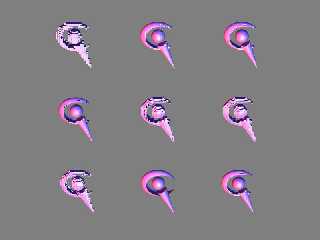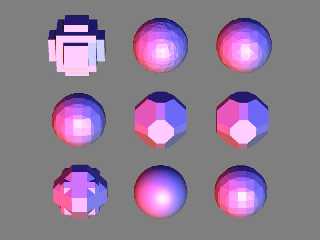 |
 |
|
 |
|
 |
|  |
|  |
|
 |
|
 |
|  |
|  |
|
 |
A sphere, made up with 7 slices,
and the pov logo, made up with more slices (about 30 or 40, I do not remember).
From top left to top right
cubicle , tesselate (from Warp code (*), corrected), tessel (derivative from Warp)
Bottom left: cristal
Bottom center: real object
Remaining: marching cube, with and without edge interpolation, using
two different tables to tesselate the cube (made respectively by Bourke and
Heller)
Three light source: red on the front left, blue on the front top right, 0.8 white in
front.
White objects.
*: marching tetrahedron
P.S.: PIP = Patch In Progress
--
Non Sine Numine
http://grimbert.cjb.net/
Puis, s'il advient d'un peu triompher, par hasard,
Post a reply to this message
Attachments:
Download 'tessel5.jpg' (23 KB)
Download 'tessel0.jpg' (26 KB)
Preview of image 'tessel5.jpg'

Preview of image 'tessel0.jpg'

|
 |
|  |
|  |
|
 |
|
 |
|  |
|  |
|
 |
<jer### [at] atosorigin com> wrote:
> A sphere, made up with 7 slices,
> and the pov logo, made up with more slices (about 30 or 40, I do not remember).
I'm not expert in those tesselating algorithms but looking at the appearance
it's still far from perfect becouse of artefacts but I suppose your PIP is on
proper way.
ABX com> wrote:
> A sphere, made up with 7 slices,
> and the pov logo, made up with more slices (about 30 or 40, I do not remember).
I'm not expert in those tesselating algorithms but looking at the appearance
it's still far from perfect becouse of artefacts but I suppose your PIP is on
proper way.
ABX
Post a reply to this message
|
 |
|  |
|  |
|
 |
|
 |
|  |
|  |
|
 |
Looks good...while not perfect, the meshes should work fine for things
like proximity calculations. I will finally be able to finish my glow
and proximity pattern patches. When are you planning to release source
code?
However, you are aware of the patent on the marching cubes algorithm,
aren't you?
--
Christopher James Huff <chr### [at] mac com>
POV-Ray TAG e-mail: chr### [at] tag com>
POV-Ray TAG e-mail: chr### [at] tag povray povray org
TAG web site: http://tag.povray.org/ org
TAG web site: http://tag.povray.org/
Post a reply to this message
|
 |
|  |
|  |
|
 |
|
 |
|  |
|  |
|
 |
Christopher James Huff wrote:
>
> However, you are aware of the patent on the marching cubes algorithm,
> aren't you?
I'll be happy to set up a distribution point for the illegal part of
this patch here in Finland where silly software patents are worth nothing.
It'll be perfectly legal to host it here. I'll have to check with some
law experts first though but it worked for some patented mp3 audio encoder.
The naughty bits were hosted here :)
_____________
Kari Kivisalo
Post a reply to this message
|
 |
|  |
|  |
|
 |
|
 |
|  |
|  |
|
 |
in news:3C745C3B.13F5BDF5@engineer.com Kari Kivisalo wrote:
> I'll be happy to set up a distribution point for the illegal part of
> this patch here in Finland where silly software patents are worth
> nothing.
You could also ask the owner of the patent if it's ok to use it in POV-Ray
and patches. Obtaining a license doesn't always mean paying for it. As far
as I know it's already in use with "no cost, available source" software:
VTK
http://www.kitware.com/
http://public.kitware.com/cgi-bin/vtkfaq?req=show&file=faq07.001.htp
http://public.kitware.com/cgi-bin/vtkfaq?req=show&file=faq07.005.htp
Ingo
Post a reply to this message
|
 |
|  |
|  |
|
 |
|
 |
|  |
|  |
|
 |
Christopher James Huff wrote:
>
> Looks good...while not perfect, the meshes should work fine for things
> like proximity calculations. I will finally be able to finish my glow
> and proximity pattern patches. When are you planning to release source
> code?
When really finished... and I just get answers which mean it will be later, due
to more development that are still to be done regarding the texture.
> However, you are aware of the patent on the marching cubes algorithm,
> aren't you?
Please provide reference to such patent, including date and description.
--
Non Sine Numine
http://grimbert.cjb.net/
Puis, s'il advient d'un peu triompher, par hasard,
Post a reply to this message
|
 |
|  |
|  |
|
 |
|
 |
|  |
|  |
|
 |
I must say, I find it kind of strange. There are errors in all examples of
the tesselated POV-LOGO. Will the marching triangle algoritm solve this
problem?
There exsist other algoritms - I'm not able to understand such high
mathematics, but have you read the various good explanations on the Internet
about (for example) Delaunay triangulation? It's widely used. I never heard
of marching cubes/triangles before.
Wouldn't it be easier to adapt an already written sourcecode in C ?
Regards,
Hugo
Post a reply to this message
|
 |
|  |
|  |
|
 |
|
 |
|  |
|  |
|
 |
In article <3C751726.20584A5E@atosorigin.com>,
> > However, you are aware of the patent on the marching cubes algorithm,
> > aren't you?
>
> Please provide reference to such patent, including date and description.
These are the two patents listed in the comp.graphics.algorithms FAQ:
http://www.delphion.com/details?pn=US04710876__
http://www.delphion.com/details?pn=US04885688__
http://www.google.com/search?hl=en&q=marching+cubes+patent
--
Christopher James Huff <chr### [at] mac com>
POV-Ray TAG e-mail: chr### [at] tag com>
POV-Ray TAG e-mail: chr### [at] tag povray povray org
TAG web site: http://tag.povray.org/ org
TAG web site: http://tag.povray.org/
Post a reply to this message
|
 |
|  |
|  |
|
 |
|
 |
|  |
|  |
|
 |
In article <3c752dc7$1@news.povray.org>, "Hugo" <hua### [at] post3 tele tele dk>
wrote:
> I must say, I find it kind of strange. There are errors in all examples of
> the tesselated POV-LOGO. Will the marching triangle algoritm solve this
> problem?
You need to generate points on the surface of the object. All these
methods can "miss" sharp edges and points...there is no way to tell them
you need points at the tip of a cone, you will need to use a special
algorithm for cones or just use such a high resolution mesh that the
errors are invisible.
> There exsist other algoritms - I'm not able to understand such high
> mathematics, but have you read the various good explanations on the Internet
> about (for example) Delaunay triangulation? It's widely used. I never heard
> of marching cubes/triangles before.
As far as I can tell (I can't find any clear explanations of it), it
takes a group of points as input and produces a surface from them. A
surface, not necessarily the surface that produced the points. And you
still have the problem of generating the points on edges.
> Wouldn't it be easier to adapt an already written sourcecode in C ?
Not really, because the POV patch will have to use existing data types
and code in POV-Ray. Having source code would make it easier to write
though.
--
Christopher James Huff <chr### [at] mac dk>
wrote:
> I must say, I find it kind of strange. There are errors in all examples of
> the tesselated POV-LOGO. Will the marching triangle algoritm solve this
> problem?
You need to generate points on the surface of the object. All these
methods can "miss" sharp edges and points...there is no way to tell them
you need points at the tip of a cone, you will need to use a special
algorithm for cones or just use such a high resolution mesh that the
errors are invisible.
> There exsist other algoritms - I'm not able to understand such high
> mathematics, but have you read the various good explanations on the Internet
> about (for example) Delaunay triangulation? It's widely used. I never heard
> of marching cubes/triangles before.
As far as I can tell (I can't find any clear explanations of it), it
takes a group of points as input and produces a surface from them. A
surface, not necessarily the surface that produced the points. And you
still have the problem of generating the points on edges.
> Wouldn't it be easier to adapt an already written sourcecode in C ?
Not really, because the POV patch will have to use existing data types
and code in POV-Ray. Having source code would make it easier to write
though.
--
Christopher James Huff <chr### [at] mac com>
POV-Ray TAG e-mail: chr### [at] tag com>
POV-Ray TAG e-mail: chr### [at] tag povray povray org
TAG web site: http://tag.povray.org/ org
TAG web site: http://tag.povray.org/
Post a reply to this message
|
 |
|  |
|  |
|
 |
|
 |
|  |
|  |
|
 |
> As far as I can tell (I can't find any clear explanations of it), it
> takes a group of points as input and produces a surface from them. A
> surface, not necessarily the surface that produced the points. And you
> still have the problem of generating the points on edges.
Thanks for your input. My understanding - though limited, but I did read
articles on delaunay triangulation some time ago - is that they generate a
very good mesh, matching the original form precisely but with few triangles.
The idea is that you trace enough points to have a very precise input for
the delaunay triangulation, which will then generate the final mesh by
carefully choosing the most important points.
I can try to find again the articles I read, if this will be useful.
Regards,
Hugo
Post a reply to this message
|
 |
|  |
|  |
|
 |
|
 |
|  |




![]()